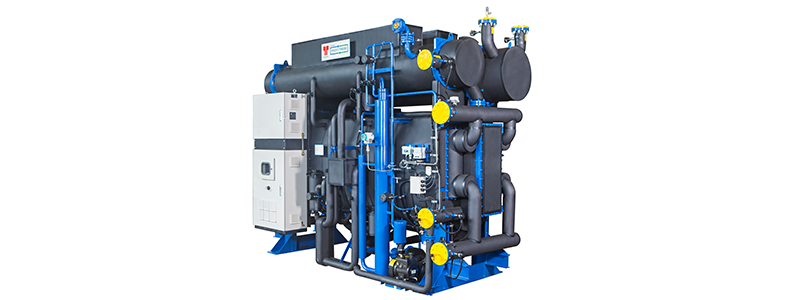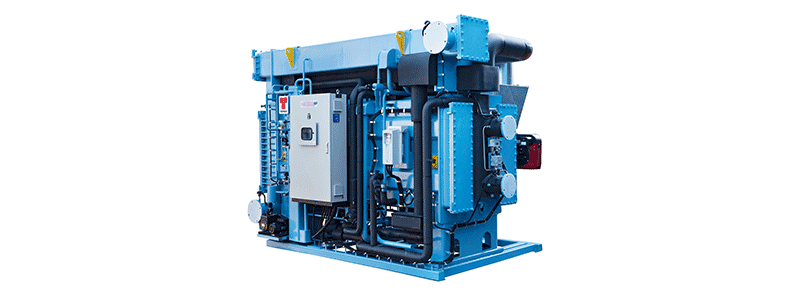Absorption heat pumps and chillers
Absorption heat pumps
The design of Danstoker’s absorption heat pumps is based on the need for energy optimization. An extra chilling of the exhaust gases makes it possible to transfer the condensing heat in the vapour steam to further improve the system efficiency. Unlike a compressor heat pump, the absorption heat pump is driven by a high-temperature energy source instead of electric power.
The absorption heat pumps have evaporator chilling capacities from 150 kW to 5,000 kW. The heat pump ”borrows” energy from the system to run the generator, and transfers/returns the borrowed energy to the system together with the energy extracted from the waste heat (exhaust gases) by the evaporator. The ratio between the total energy produced and the energy ”borrowed” is 1.7. This ratio is known as the COP value.
Driving energy (auxiliary heat source), absorption heat pumps:
Absorption Chiller
The design of Danstoker’s absorption chillers is based on the need for industrial process cooling and comfort cooling in buildings.
Industrial production involves numerous production stages where electricity is currently used to cool down critical processes. However, the installation of an absorption chiller allows the industrial companies instead to utilize their waste heat to produce cooling.
As standard, the absorption chillers have an evaporator chilling effect of 50 kW to 3,500 kW. If required, combinations of several units may be designed to achieve a higher capacity.
The waste heat is used as auxiliary heat source to the chiller’s internal cycle, which offers a ratio between the total energy produced and the ”waste heat borrowed” of 0,7 to 0,8. In order to release the total energy generated by the waste heat + the process cooling, the heat pump’s hot water circuit must be connected to a cooling tower and discharged to open air.
The chilling effect of absorption chillers may be designed to achieve evaporator temperatures as low as -5 °C in a water/LiBr unit. As a result, freezing temperatures can be achieved by equipment, which is not subject to the pressure equipment directive, thereby eliminating the need for annual inspections by the supervising authorities.
Driving energy (auxiliary heat source), absorption chiller:
ABSORPTION HP
- Flue gas, steam or high pressure hot water
- Type
- Heat pump type I.Used in district heating and in the technical industry
- TecHnical info
- Hot water: up to 80 °C.Heat source: flue gas, steam, high pressure hot water.COP: 1,7 – 1,85
- Capacity (kW)
- Heat: 500 – 40.000 kW
ABSORPTION HP, DIRECT FUEL FIRED
- Oil/gas
- Type
- Heat pump type I.Used in district heating and in the technical industry
- Technical info
- Hot water: up to 80°C.Heat source: NP, LPG, CNG or HSD.COP: 1,4 – 1,45
- Capacity (kW)
- Heat: 200 – 10.000 kW
ABSORPTION CHILLERS
- Flue gas or hot water
- Type
- Plant type according to design criteria.Cooling technology and air-conditioning
- Technical info
- Lowest outlet temp. chilled water: -5°C. Desig inlet temp. cooling water: 25 – 32°C. Min. inlet temp. cooling water: 10°C.Heat source: flue gas down to 270°C or hot water (80-120°C).COP: 0,7 – 0,8
- Capacity (kW)
- Cooling capacity: 50 – 3.500 kW




